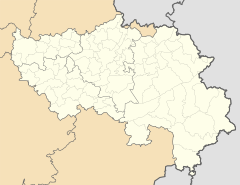Lincé
| Lincé | ||
|---|---|---|
|
|
||
| State : |
|
|
| Region : | Wallonia | |
| Province : | Liege | |
| District : | Liege | |
| Coordinates : | 50 ° 31 ' N , 5 ° 38' E | |
| Post Code: | 4140 | |
The village of Lincé is a district of the municipality of Sprimont in the province of Liège in Belgium .
history
During the annexation of the southern Netherlands by the French Republic in 1795, the place was part of the Ourthe department .
First World War
Lincé gained notoriety during the First World War through a massacre by the German Army . The Major General Karl-Ulrich von Bulow , brother of the then Chancellor Bernhard von Bülow , marched on August 5, 1914, the 9th Cavalry Division as part of the Schlieffen Plan , north of Luxembourg in Belgium one. The troops quartered themselves in the village, which had 800 inhabitants at the time, but shots were reported at midnight. Von Bülow suspected an attack by Belgian snipers and reacted with great severity. He ordered the fire back and Lincé burned down. Eleven Lincé residents were killed in the course of the nightly turmoil. When the battle subsided, he organized a court martial that sentenced 23 men between the ages of 16 and 73 from Lincé to death by shooting. The sentence was carried out early in the morning of August 6, 1914, with a shot in the neck. 11 more civilians, including 3 teenagers and a ten-year-old girl, had already died that night. The next day it became clear that the attack was unjustified, as all Belgian and French military units were out of range. The German soldiers did not find any weapons among the executed. Probably out of despair over his failure as a commander committed Karl Ulrich von Bulow near the castle of Lincé on August 7, 1914 suicide . His death was first portrayed in the propaganda as the “first general to fall”. However, a few weeks later, the truth emerged. Bernhard von Bülow then tried to portray death as the result of hostile actions, but it did not succeed.
Monuments
The Hazotte Monument was erected to commemorate the victims in Lincé on the edge of the Rue d'Ogné. It is a modern menhir from the Lille quarry . There is also a monument with plastic and an inscription with the names of the victims in the village itself. This is from 1962 as the 1920 memorial was removed and melted down during the German occupation (1943).
literature
- Peter Winzen : Midnight excess . In: Spiegel Online . February 27, 2011
Individual evidence
- ↑ Monument Hazotte http://www.ourthe-ambleve.be/insitu/fiche.php?lang=d&cle=7735 ( page no longer available , search in web archives ) Info: The link was automatically marked as defective. Please check the link according to the instructions and then remove this notice.
- ↑ Monument from 1962 Archived copy ( Memento of the original from October 21, 2016 in the Internet Archive ) Info: The archive link was inserted automatically and has not yet been checked. Please check the original and archive link according to the instructions and then remove this notice.

